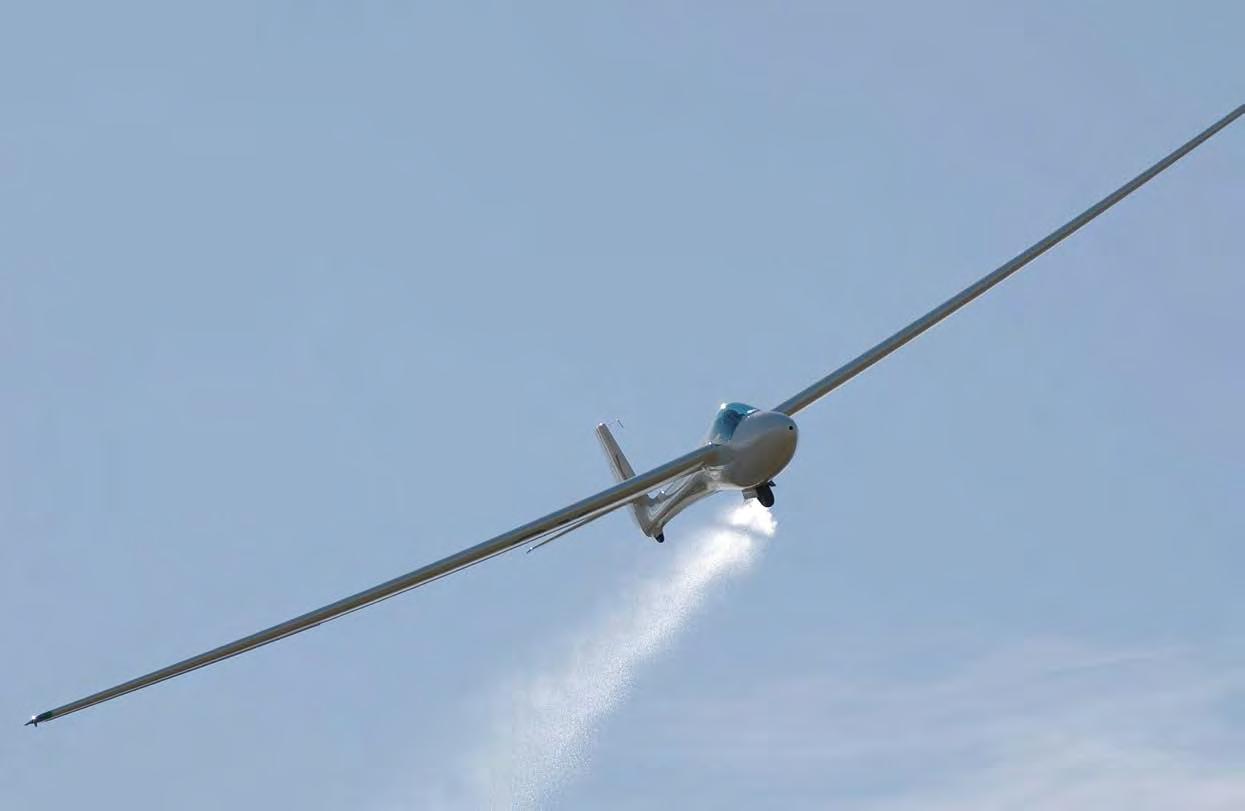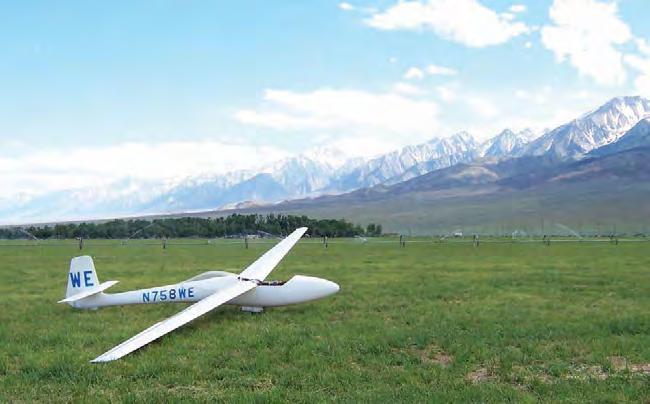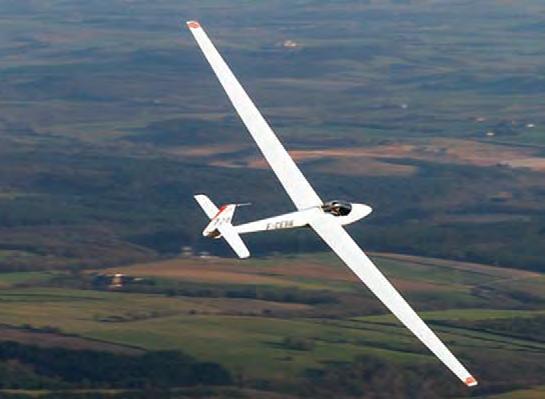
10 minute read
The Allure of the Libelle
from SoaringNZ Issue 11
by mccawmedia
In December 1966 an article appeared in Soaring magazine entitled ‘There’s Fiberglass in Your Future’. The Libelle, the first of the Glasflügels, German for “glass wing”, marked the beginning of a radical change in the development of sailplanes and in the sport of soaring.
Terry Delore’s historic Libelle GGK, known these days as “Shrek”. Now fitted with winglets to bring it into the modern era this little ship has no trouble flying long distance flights, even on winter days’. This is the ship Abbey Delore is pining for (see article last issue)
Advertisement

The Hutter H-301 Libelle, was introduced to the world in 1964. The Libelle and its various incarnations (H-301, H-301B, H-201, H-201B Standard Libelle and the Club Libelle 205) went on to take the soaring world by storm, ranking in the top numbers of contests around the world for several years, becoming the favourite of soaring pilots everywhere and talked about as the glider nearly every pilot would like to own.
That original Libelle was designed and built by Wolfgang Hutter and the husband and wife team of Eugen and Ursula Hanle, the founders of the Glasflugel company. The design process began first in the various rooms of the Hanle house and later in workshops. Surprisingly the Dragonfly [as they called it] was a development from the jet-powered self-launching H-30TS built by Wolfgang which was itself a development of the diminutive wooden

This story was printed in the American Soaring magazine in June. It was brought to our attention by Graham Lake of the Auckland Aviation Sport Club. Graham is an enthusiastic Libelle pilot and he will be following this up with an article on Libelles in New Zealand very soon.
Soaring magazine noted the Libelle as “… the most beautiful sailplane in the world” after its appearance in the gliding world in 1964.
By Neita Montague
GLASFLÜGEL H201 LIBELLE
Hutter H-28 of the 1930s built by Wolfgang and his brother Ulrich. Quite an intriguing heritage for what would eventually become the very first fiberglass airframe of any type awarded a Standard Type Certificate (in September of 1965) by the FAA – and which would, in this way, become the grandfather of every one of today’s modern composite aircraft. Designers from Rutan to Airbus have simply continued what the tiny Libelle started. The evolutionary Libelle was a most revolutionary aircraft!
Libelles were known for their speed and climbing abilities. A Libelle photo from the 1966 National Soaring Championships carries the caption, “A view of the Hutter Libelle that more and more competitors seemed destined to see – the bottom.” A summary of the long soaring flights of 1966 show the Libelle with the highest average distance. The H-301B sold for US $5,300 ex-factory plus $300 for the optional tail chute.

15 m 6.2 m 1.31 m 9.8 m² Wortmann FX 66-17A 11-182 23 185 kg 350 kg 50 kg ? 38 33.5 kt 0.60 m/s 135 kt 135 kt
THE ALLURE OF THE LIBELLE
PERFORMANCE DATA Span Length Height Wing Area Wing Section Aspect Ratio Empty Glider Mass All-Up Mass Water Ballast Load Factors Maximum L/D Stalling Speed Minimum Sinking Speed Max. Rough Air Speed Never Exceed Speed
Thirteen Libelles entered the 1967 U.S. Nationals held in Texas; the highest placed Libelle flown by Ben Greene came in fifth. The following year he was first. The Glasflugel Fiberglass Fleet went on to claim all three of the world’s major speed marks: 100, 300 and 500-km Triangle.
The revolutionary construction of sandwiching fiberglass and balsa was causing concern, leading the Braunschweig Insititute of Technology to test the Libelle wing to the equivalent of 41,400 hours of flying. This is 13.8 times their nominal 3000 hour test! At that time no other sailplane had been subjected to such an extended test program.




That same year the first flight of the H-201, called “the improved Libelle,” took place. It had fixed gear but lacked the manoeuvrability of the H-301 in take-offs and landings, so many tail booms suffered damage. Chip Bearden on www.recsoring.org wrote that, “The 201s were infamous for breaking in ground loops. I still remember seeing a 301 at the 1981 U.S. 15 m Nationals at Minden with external longerons glassed onto the exterior of the rear fuselage.”
In the 1968 FAI World Championships in Poland, Per Axel Persson from Sweden placed second in a Standard Libelle, losing by 150 points, while competing against the likes of the Elfe S-3 (one flown by A.J. Smith and one by George Moffat), the Phoebus A, Foka, and AS-W 15, only a few of the great variety of ships flying the eight-day contest.
At the 1971 U.S. Standard Class Championships Libelle pilots finished in the first five places, the H-301s with their flaps locked! In 1972, twenty-seven Libelles competed in the U.S. Standard Class Nationals in Marfa, Texas. 1971 was a great year for Libelle pilots. They finished in the top five places in the 39th U.S. Soaring Championships at Minden, Nevada. The Libelles were trouncing the Kestrel (a later Glasflugel), the ASW-12, ASW-17, the Cirrus, the Diamant 18, and the Nimbus II. The world was stunned.
Looking at all the contest final rankings during the 1970s is quite fun. You can note the top Libelle drivers jockeying for the top positions, trading places throughout the years. Other names you see during these years are Neil Armstrong and Wernher von Braun, who were also Libelle owners but did not compete. The U.S. Nationals saw 20 Libelles competing in 1973.
In 1974 the Glasflugel firm ordered a large wreath with the letters “500” and leaned it against the nose of its 500th Standard Libelle. “More have been built than any other fiberglass airplane” is the caption of its picture in front of the factory. At that time they were producing 10 Libelles a month.
The Libelles were going farther and faster. For six days James Smiley held the World Out and Return Record of 650 statute miles and a 72.2 mph average. Henry Combs in 1998 earned his 200th Diamond in Libelles.
Wil Schuemann had instituted performance enhancements to the wings and fuselage of his own ship and in the ’70s freely provided advice, data and drawings for others with the resulting enhanced performance equal to that of the mighty ASW 12, except at high speeds – where it was superior! Not bad for a 15-metre “pocket battleship”. Wil’s presentation from the SSA Convention of that same year is available on http://www.betsybyars.com/guy/ soaring_symposia/72-modif.html.
The Libelles were also going higher. Marcel Godinat, member of the 1936 Swiss Soaring Team at the Olympics, in an H-201 set a Nevada State Record out of Minden of 30,000 ft. In successive years he went on to 37,000 ft for a personal best.
There were originally 111 Libelle H-301s. The 600 Libelle H-201s were designed without flaps, without the optional tail chute, and with a new Wortmann wing. They were built from 1967 to 1975, along with a variation, the H-210B and were produced until 1974. There were several experimental design developments which though flown never went into production, the H-202 , H-203 and the H-204.
Then the Club Libelle (H-205) came into being of which 171 were built. It was created with a t-tail, no flaps, fixed gear, used the Wortmann wing and was designed for the low-time pilot, club use and off field landings. It has an unusual type of trailing edge air brake which is similar to those on the Mini Nimbus and the Mosquito.
Many of the nearly 900 various types of the Libelle are still flying in a wide number of countries. The H-301 life limit is 12,000 hours – enough for several lifetimes of great soaring. Imagine how nice your daughter will look, flying your father’s Libelle.
Until the death of Herr Hanle, the Glasflugel firm continued with the ‘insect’ theme pioneered by the Dragonfly Libelle. The Hornet was the Standard Class successor to the H-201 and 151 were built including the Hornet C. The Mosquito (200 built) was the first Glasflugel designed for the then-new 15-metre racing class. (The H-301, retrospectively recognised as the first sailplane of that class, was designed before the 15-metre racing class existed. In a sense, it helped bring about the existence of this class – another ‘first’ for the seminal Libelle.)
Ursula Hanle went on to design the aerobatic Salto, using H-201 wings cut down at the root to 13.6 meters with trailing


edge brakes, and a V-tail. Sixty of them were built. Even the HBV Diamant – which flew on a set of H-301 wings – was a descendent of the original Libelle.
The Libelle name had such allure that the original marketing name of the H-401 Kestrel was, in fact, the Super Libelle. The name was later changed, probably because it was somewhat redundant! Besides the 129 H-401 Kestrels built, the Glasflugel company produced a variant, the H-604 Kestrel 22. The Glasflugel H-304 (CZ) is still being produced today – more than thirty years after its introduction.
While most people will run in the opposite direction when they see a Duo Discus ready to rig, many will gladly pitch in to help with the Libelle. It takes just two people and only a couple of minutes to put it together. One pull on the spar butts with a specially designed tool bring the wings “home” with a satisfying “clunk.” And unlike most ‘modern’ sailplanes, a Libelle’s spar carry-through sits out in the open, in plain view where it’s simple to see while rigging. As a result, rigging is fast and easy, to the great relief of the helper on the wingtip!
In 2005 there was a discussion in Australia of holding a Libelle competition, and in Germany a Libelle Gathering was held on 08/08/08. Libelle lovers in France will hold their 3rd Libelle Cup in Issoudun, France this summer. The first U.S. Libelle Gathering was held in July.
The Libelle is a true classic – an instant hit that still has a devoted group of owners who love to fly this little machine. Forty years later, hundreds of pilots around the world still count themselves as fortunate to own or fly Libelles.
Technology may have moved on past the Libelle – but as any Libelle pilot will tell you, it hasn’t moved very far! Truly, the Libelle was a tremendous achievement, and far ahead of its time.
Soaring Libelle Covers Over the Years:
Soaring has produced nine covers showing the Libelle in its various versions: March 1996, September 1968, January 1969, August and December 1970, November 1971, April 1978, March 1980 and June 1980. The October 1970 cover shows a grid full of Libelles. There are also several “Soaring Calendar” pictures.
It’s only in the event of a
CLAIM that you really find out who has the best policy!
Contact your broker or ring Brian or Arden and talk to the people who specialise in aviation insurance. “Kiwis providing Glider pilots with aviation insurance for over 25 years”

TELEPHONE 04 473 5593 a d m i n @ a v i a t i o n c o o p . c o . n z www.aviationcoop.co.nz
are re-webbed, relabelled and released to service as an approved supplemental part to the aircraft.
About the Author: Neita Montague, a power pilot with 2200 hours, was introduced to soaring by her husband ten years ago. She owned a Ka6CR and now owns an H-301Libelle, N7115, S/N 50 and flies out of Reno, Nevada. She is President of the Women’s Soaring Pilots Association and a member of the Reno High Sierra 99s.

On completion of your re-webb we will issue an authorised release cerificate CAA Form 1 for release to service.










